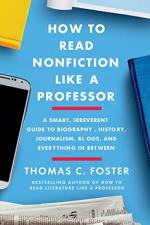
|
| Name: _________________________ | Period: ___________________ |
This test consists of 5 short answer questions, 10 short essay questions, and 1 (of 3) essay topics.
Short Answer Questions
1. Using an argument like "Democrats just want to take your guns" in an address to a gun rights organization in a heavily Republican area would be an example of which flaw in argumentation?
2. In "Interrogating the Text," Foster says that readers should beware of ad hominem arguments. What he means is that readers should be suspicious when writers do what?
3. In Chapter 10, "From the Inside Out," which writer does Foster credit with originating the essay?
4. Based on Chapter 14, "The Universe of Ideas/Ideas of the Universe," what would Foster call a journalist writing a general survey of the field of string theory?
5. In Chapter 15, "Reading Internet Sources," what does Foster say leads to better thinking?
Short Essay Questions
1. In Chapter 14, "The Universe of Ideas/Ideas of the Universe," what are the three types of science writing that Foster describes, and what are the differences among them?
2. In Chapter 11, "Life from the Inside," what does Foster say is the difference between autobiography and memoir?
3. In Chapter 11, "Life from the Inside," why does Foster spend time describing the contents of Cardinal Newman's autobiography?
4. In Chapter 10, "From the Inside Out," why does Foster say that the process newspapers follow to assure balanced treatment in opinion pieces creates a false dichotomy?
5. In Chapter 9, "Living the News," what does Foster admire about the writing of John McPhee?
6. In Chapter 12, "That Is So Last Year," what difference does Foster explain between primary and secondary sources?
7. Explain why, in Chapter 11, "Life from the Inside," Foster says that the narrators of nonfiction can be just as unreliable as the narrators of fiction.
8. In Chapter 15, "Reading Internet Sources," what does Foster say is problematic about the internet and web?
9. In Chapter 15, "Reading Internet Sources," what does Foster propose as a solution to inaccuracies on the web?
10. Which of the three writers that Foster discusses in Chapter 13, "On the Stump," does Foster find to be least reliable, and which does he find to be most reliable? Why is this?
Essay Topics
Write an essay for ONE of the following topics:
Essay Topic 1
In Chapter 10, "From the Inside Out," Foster argues that the essay began with the Enlightenment. Many of the works that he cites were called "treatises" by their authors, however. Look up the similarities and differences between an "essay" and a "treatise." Then look up the writings of Ancient Greek philosophers such as Aristotle. Write an argument of definition in which you take a stand about whether the essay and the treatise are the same or different types of writing; in your essay, take a stand about when the "essay" becomes a distinct type of writing.
Essay Topic 2
Does Foster follow his own advice and "rules" in this book, or does he say one thing and do another? For instance, in Chapter 1, "The Structure of Nonfiction Information," Foster says the first job of the writer, on page one, is to get the reader to be interested enough to read page two. When you got to the end of page one, how interested were you in reading page two? Does this mean that Foster followed his own advice, or not? Consider the rest of the book in this way. Use specific textual evidence to evaluate whether How to Read Nonfiction Like a Professor lives up to the standards that Foster sets for other authors.
Essay Topic 3
Based on the language and tone of Foster's book, who is his imagined audience? Is this audience consistent throughout the book? Give specific textual examples as you analyze how Foster's language and tone reveal the presumed audience for this book.
|
This section contains 1,079 words (approx. 4 pages at 300 words per page) |

|




